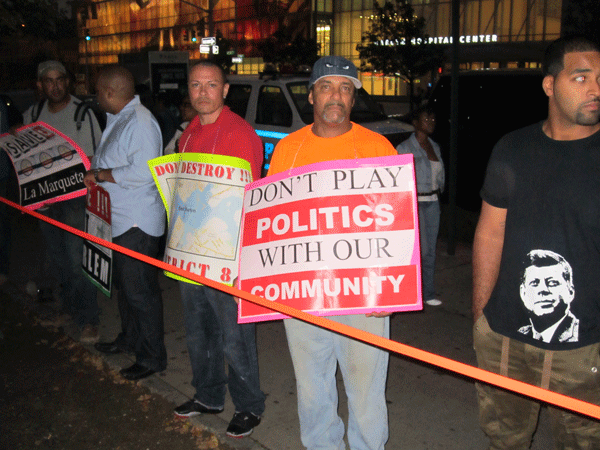SCARY BID HEARING:
A date has at last been set for a hearing on the proposed Broadway-Soho Business Improvement District. Scheduled on Halloween, Wed., Oct. 31, at 10 a.m. in the City Council Chambers at City Hall, it’s technically an “oversight” hearing, according to Kelly Magee, communications director for Councilmember Margaret Chin. “There will not be a vote at the hearing,” Magee explained. “Depending on the hearing, a date will be set for a legislative hearing, which will start the 30-day clock for people to log their opposition. From there, there would need to be a vote in the full Council, if we get that far.” We assumed that, during the 30-day comment period, people could also “log their support” for the BID. But Magee informed us that actually it’s just for opposition.

MARQUETA MEDIATOR GLEASON:
We thought the struggle over whether or not to create an Asian-Latino City Council district in Lower Manhattan was contentious — that is, until we attended the Districting Commission’s hearing in Harlem a couple of weeks ago. The auditorium of the Schomburg Center on Malcolm X Ave. was packed with East Harlem residents furious over the commission’s plan to sever off part of El Barrio in District 8, specifically La Marqueta, the sacred heart of the neighborhood. Redistricting is done every 10 years to balance out populations based on Census tract variations, but as more than one resident called out incredulously, referring to La Marqueta, “No one even lives there!” The beloved market is the Uptown version of the Essex St. Market, but with a deeply Latino flavor, not the multicultural feel of the Lower East Side vendors hotbed. As the crowd’s chanting of “Save East Harlem!” reached deafening levels, the commission members left the stage for several minutes. Out of nowhere, former City Council candidate Pete Gleason jumped up at the front of the auditorium and tried to get people to settle down. Raising his arms, he tried to yell over the crowd’s din, “These forums are set up to give you a limited amount of time… .” It wasn’t really working, so he scrambled up onto the stage and continued from there, but a police officer came up and politely told him to exit stage left, which he did. Maybe Gleason’s attempt at mediation did help a bit — or maybe it was the residents’ threats that the commissioners had better get their butts back out there — but they eventually did emerge to retake their seats. Anyway, Councilmembers Chin and Rosie Mendez were both there to testify in favor of keeping the district lines as they are now. Mendez said the alternative scheme offered by the “Unity Map” — to cut off her district at Houston St. all the way across to the East River — would remove a substantial amount of low-income residents from her district, which wouldn’t help it keep its minority population. Chin said she also opposed the alternative redistricting map because it would cut Battery Park City and part of the Financial District, which have a growing population, out of her district. We also saw West Village politico Frieda Bradlow seated patiently in the audience. She had testified at the Districting Commission’s previous Manhattan hearing, advocating for the need to “unify the historic Village district,” which today is split between Districts 1, 2 and 3, weakening its cohesiveness and power to fight off unwanted development projects. Asked, during a lull in the uproar, if she was going to testify this time, Bradlow just smiled and said she didn’t know if she’d get the chance. Speaking afterward, Mendez said she, too, worried what might happen to La Marqueta — which one speaker called “the jewel of the Puerto Rican community.” Mendez said she was concerned if La Marqueta was shifted into what she called a “supermajority white district,” like the ones currently represented by Councilmembers Dan Garodnick or Jessica Lappin, that people would no longer care about it or recognize its significance. “If they need a garage, they might put it there,” she said. As a kid growing up in Williamsburg she had a connection to La Marqueta, since her great-aunt who lived in El Barrio and chewed tobacco would buy it there, and would take her along when Mendez would visit her.


















